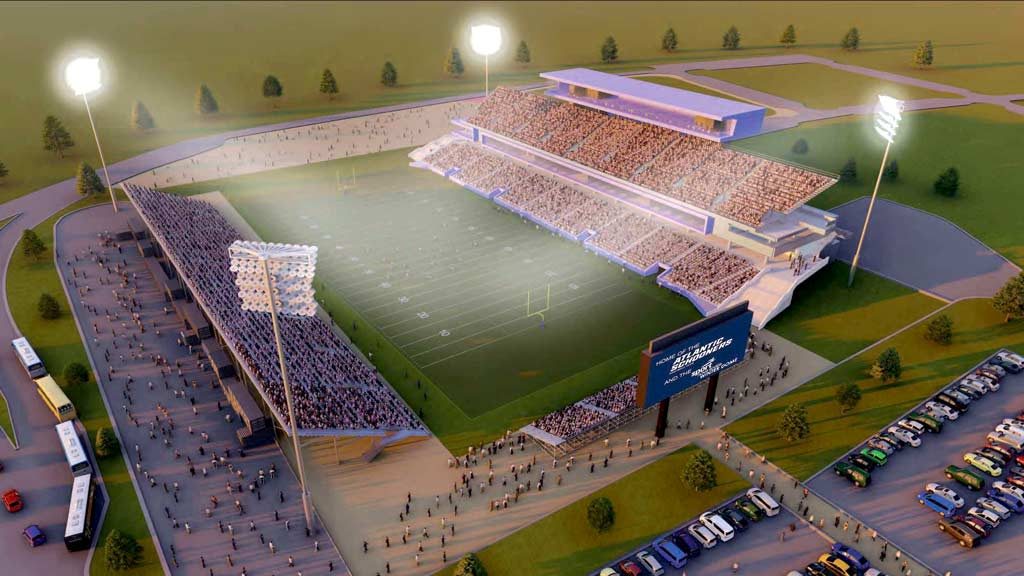Schooners Sport and Entertainment (SSE) wants to build a $100-million Canadian Football League (CFL) stadium in Halifax, N.S., that would be an epicentre for world-class entertainment and sports in Atlantic Canada.
The plan calls for a multi-use community facility with more than 24,000 seats to be erected on an eight-hectare parcel of land owned by Canada Lands at Shannon Park on the eastern shore of Halifax Harbour in Dartmouth.
The structure would have several interesting features, including an inflatable dome over the field which would allow it to be operated and used by schools and provincial sports organizations year-round.
Plans have been presented to Halifax Regional Municipality (HRM). As of press time, planners were still analyzing the proposal.
“Based on our discussions with the community and various stakeholders, we believe the city and region wants and deserves a community stadium,” says SSE lawyer David Wallace. “We have put together a comprehensive proposal addressing the various issues and requests raised by the city and province.”
SSE is led by AMJ Campbell Van Lines president Bruce Bowser, lawyer Gary Drummond who owned the National Hockey League’s (NHL’s) Arizona Coyotes, and Anthony LeBlanc, another former owner of the Coyotes.
The CFL is working with Halifax on a league franchise and the stadium is a necessary part of the deal. The group’s projected timeline for starting the project is February 2020 with a finish date of October 2022.
SSE has been working on the proposal for the better part of two years. It is estimated the venture would generate upwards of 3,000 full-time construction jobs and another 2,000 for ongoing operations.
Halifax has studied the feasibility of building a stadium five times since 1986 in anticipation of bidding for international sporting events. However, each time studies were undertaken without confirmation of an anchor tenant. This time is different, though, as SSE has a secured a conditional CFL expansion franchise.
Wallace says SSE wants to build the stadium to provide free access to first-class facilities for community youth organizations, schools and provincial sports organizations and to attract large events.
“We believe that access to sport and recreation infrastructure plays a critical role in the development of individuals and generating positive social benefits in communities. A lack of affordable access to such facilities is the largest single barrier to realizing these benefits. We believe that our free access model will positively address this issue.
“Second, a stadium of this magnitude will provide HRM and Nova Scotia with the opportunity to host a myriad of additional events that are international in scope, enhancing the region’s profile and driving tourist revenue,” says Wallace. “HRM is the only major city in Canada without this type of infrastructure. We believe the region deserves this, and we have been working very hard to try to make it a reality.”
The price tag of the stadium is pegged at $94 million, with an additional $10 million for land acquisition costs.
SSE has proposed five different funding options to the municipality. The plan favoured by the group is to borrow the money from a third-party lender and pay back $5 to $6 million a year over a 30-year period. SSE would commit to $2 million annually to the lender and the municipality would pay $3 to $4 million a year from increased revenue collected via a hike in the existing hotel bed tax and a new rental car tax.
“The idea here is that these amounts are incremental, and ultimately the increased tourist activity a stadium generates contributes to the funding of the facility,” says Wallace.
A statement released by HRM CAO Jacques Dube indicated that the proposal released by SSE addresses a range of topics such as the design and costs for the stadium, timing of the build, and funding and finance.
Over the coming months, he noted, the project team will analyze the proposal to make sure it aligns with integrated mobility and strategic recreation plans of the municipality, do a comprehensive financial analysis and review benefits of a stadium in Shannon Park.
“Given the significant scope and scale of the proposed initiative, careful and extensive analysis is required on the part of the municipality. To provide council with the thorough analysis and insights it requires to make a well-informed decision on this matter, the municipal project team must complete its due diligence.”
As for the timeline, Dube said he expects to present a report with recommendations to regional council in late winter or early spring.
The stadium, meantime, would be integrated into a larger, master-planned, mixed-use community at Shannon Park.
Once fully built-out, Wallace expects the area will be a vibrant community and the stadium will enhance the desirability of nearby residential and commercial offerings.
He says the developers have had follow-up conversations with the city and province to address questions and that they are ready to go.




The time is now!Let’s go !!
Looks to be a rather basic although well laid out field. It is now just a matter of how great the population and local interest is for the CFL as many other events will have to occur for over 100 days each year to ever by profitable.